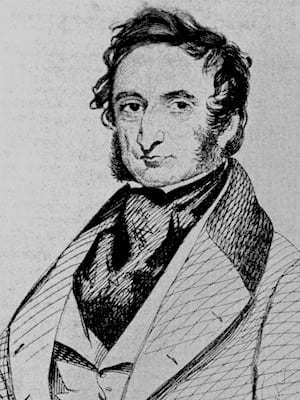Robert James Graves
Biography
- Born 27 March 1796, Son of Richard Graves Regius Professor of Divinity, University of Dublin
- 1818 – Medical degree, University of Dublin.
- 1819 – Studied in London, Berlin, Paris, Gottingen, Copenhagen and Vienna
- 1821 – Physician to the Meath Hospital, Dublin
- 1824 – One of the founders of the Park Street School of medicine
- 1835 – Described exophthalmic goitre (Graves disease)
- 1838 – Co-founded the Pathological Society of Dublin along with Smith, Colles, Corrigan and Stokes
- 1843 – President of the Royal College of Physicians of Ireland
- 1849 – Fellow of the Royal Society of London
- Co-founder of the Dublin Journal of Medical Science
- Died 20 March 1853
Medical Eponyms
Graves disease (1835)
[*aka Basedow disease, Parry disease]
Graves delivered a series of lectures at the Meath Hospital, Dublin in 1834–1835. In his lecture ‘Newly Observed Affection of the Thyroid Gland in Females‘ Graves describes three patients with goitre and palpitations. A fourth patient, seen by seen by his colleague Sir William Stokes was a ‘lady aged twenty, affected with some symptoms which were supposed to be hysterical‘ exhibited the additional sign of exophthalmos. This young lady presented with palpitations, swelling of the thyroid and nervousness…
…the eyeballs were visibly enlarged, to such a degree the eyelids were unable to shut during sleep and when trying to close the eye. When the eyes were open the white of the eyes could be seen in the breadth of several lines around all of cornea.
Graves, 1835; 517
Graves Ophthalmopathy – constellation of findings, apparent in 25- 50% of patients with Graves disease.
Key Medical Attributions
Guillain- Barré syndrome (1843) Graves observed the remarkable and obscure, epidemic of acute sensori-motor polyneuropathy in Paris during the summer of 1828. This was first described by Auguste-Francois Chomel (1828) as the epidemie de Paris. Graves’s first account was in 1843 in his Clinical Lectures
Angioneurotic edema [*aka Quincke’s disease] Graves provided an early description of ‘fugitive inflammation‘ in his lectures on gout in 1843
Controversies
Graves’ proficiency in German lead to his arrest in Austria as a spy because no “Englishman” could speak German as well as he did
Graves had long been heralded as the uncredited inventor of the second-hand on watches. However his role was only to extol the virtues of the second hand in the accurate assessment of the pulse in the clinical setting…it was English physician Sir John Floyer (1649-1734), in 1707 who invented the pulsometer watch and therefore the seconds hand.
Floyer was renowned for his work on the study of the pulse and believed understanding a patient’s pulse was fundamental to elucidating a diagnosis. He developed the pulsometer watch with London watchmaker, Samuel Watson. It enabled him to become the first physician to study the pulse in his clinical practice. He published The Physician’s Pulse-watch Volume I 1707 and Volume II 1710.
Major Publications
- Graves RJ. Newly observed affection of the thyroid gland in females. London Medical and Surgical Journal. 1835;7:516-517
- Graves RJ, Stokes W. Clinical reports, of the medical cases in the Meath Hospital and County of Dublin. 1827
- Graves RJ. Clinical lectures. 1835
- Graves RJ. A system of clinical medicine: Notes and a Series of Lectures. 1843
- Graves RJ. Clinical lectures on the practice of medicine. Volume I. 1848. [Volume II]
- Graves RJ. Gout. In: Clinical lectures on the practice of medicine (2e). 1848; I: 462-463. [angioneurotic edema]
- Graves RJ. Pathology of Nervous Diseases. In: Clinical lectures on the practice of medicine (2e). 1848; II: 504-505. [Guillain- Barré syndrome]
References
Biography
- Biography: Robert James Graves. Medical Classics 1941;5:21
- Whitehead RW. Robert James Graves, physician, educator, scientist. Circulation. 1969; 39(6): 719-21.
- O’Brien ET. Dublin Masters of Clinical Expression: IV. Robert Graves (1796-1853). J Irish Colleges Physicians & Surg 1975;4:161-163.
- Smyth PPA. Robert James Graves (1796-1853). European Thyroidology Association
Eponymous terms
- Cadogan M. Eponymythology: Diffuse Toxic Goitre. LITFL
- Cadogan M. Eponymythology: Graves Orbitopathy. LITFL

